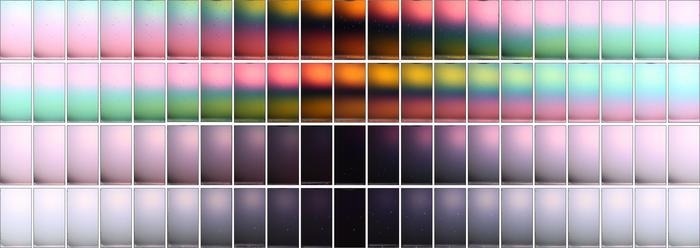Some molecules exist in two forms, such that their structures and their mirror images are not superimposable, like our left and right hands. As a result of their asymmetry, these molecules exhibit a trait known as chirality.

The photos depict the vibrant colors exhibited by the dispersion of magnetic nanoparticles when subjected to magnetic fields with varying chiral distributions, as observed through polarized lenses. Image Credit: Jonas Reuel/iStock/Getty Images Plus.
Chiral molecules are optically active because of how they interact with light. In nature, only one form of a chiral molecule, such as DNA, exists. Surprisingly, if a chiral molecule is beneficial as a drug, its mirror image may be ineffective for therapy.
A group led by chemists at the University of California, Riverside, discovered that a magnetic field's distribution is chiral while attempting to manufacture artificial chirality in the lab.
We discovered that the magnetic field lines produced by any magnet, including a bar magnet, have chirality. Further, we were also able to use the chiral distribution of the magnetic field to coax nanoparticles into forming chiral structures.
Yadong Yin, Professor, Chemistry, University of California, Riverside
Researchers have traditionally utilized “templating” to create chiral molecules. A chiral molecule is first used as the template. Achiral (or non-chiral) nanoparticles are then assembled based on this, enabling them to sort of copy the structure of the chiral molecule.
The downside of this technique is that it cannot be applied uniformly because it is highly dependent on the precise composition of the template molecule. Another limitation is that the freshly produced chiral structure cannot be conveniently positioned on, say, electronic equipment.
But to gain an optical effect, you need a chiral molecule to occupy a particular place on the device. Our technique overcomes these drawbacks. We are able to rapidly form chiral structures by magnetically assembling materials of any chemical composition at scales ranging from molecules to nano- and microstructures.
Yadong Yin, Professor, Chemistry, University of California, Riverside
Yin revealed that his team’s method generates chirality by using permanent magnets that rotate in space on a regular basis. He said that chirality is transferred to achiral molecules through doping, which involves integrating guest species like polymers, metals, semiconductors, and dyes into the magnetic nanoparticles used to create chirality.
The findings of the study were published in the journal Science.
When chiral materials interact with polarized light, they produce an optical effect, according to Yin. Light waves vibrate on a single plane in polarized light, lowering the total intensity of the light. As a result, polarized lenses in sunglasses reduce glare, whereas non-polarized lenses do not.
If we change the magnetic field that produces a material’s chiral structure, we can change the chirality, which then creates different colors that can be observed through the polarized lenses. This color change is instantaneous. Chirality can also be made to disappear instantaneously with our method, allowing for rapid chirality tuning.
Yadong Yin, Professor, Chemistry, University of California, Riverside
The observations could be useful in anti-counterfeit technology. A chiral pattern indicating the authenticity of an object or document is invisible to the naked eye but visible with polarised glasses. Other uses of the discoveries include sensing and optoelectronics.
“More sophisticated optoelectronic devices can be made by taking advantage of the tunability of chirality that our method allows. Where sensing is concerned, our method can be used to rapidly detect chiral or achiral molecules linked to certain diseases, such as cancer and viral infections,” notes Zhiwei Li, the first author of the paper and former graduate student in Yin’s lab.
A group of graduate students from Yin’s lab, including Qingsong Fan, Zuyang Ye, Chaolumen Wu, and Zhongxiang Wang, assisted Yin and Li in their research. Li is now a Postdoctoral Researcher at Northwestern University in Illinois.
The National Science Foundation provided funding for Yin’s research. The UCR Office of Technology Partnerships has applied for a patent on this work.
Journal Reference:
Li, Z., et al. (2023). A magnetic assembly approach to chiral superstructures. Science. doi.org/10.1126/science.adg2657.